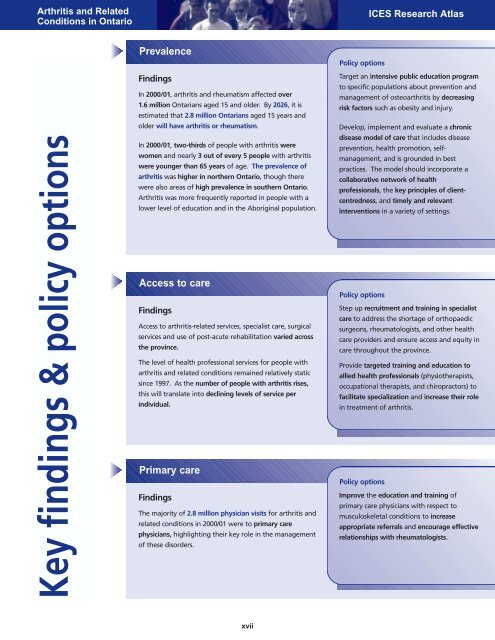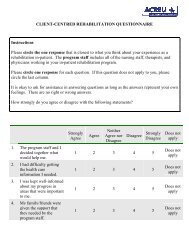Introduction - Arthritis Community Research Evaluation Unit (ACREU)
Introduction - Arthritis Community Research Evaluation Unit (ACREU)
Introduction - Arthritis Community Research Evaluation Unit (ACREU)
Create successful ePaper yourself
Turn your PDF publications into a flip-book with our unique Google optimized e-Paper software.
<strong>Arthritis</strong> and Related<br />
Conditions in Ontario<br />
ICES <strong>Research</strong> Atlas<br />
Prevalence<br />
Policy options<br />
Key findings & policy options<br />
Findings<br />
In 2000/01, arthritis and rheumatism affected over<br />
1.6 million Ontarians aged 15 and older. By 2026, it is<br />
estimated that 2.8 million Ontarians aged 15 years and<br />
older will have arthritis or rheumatism.<br />
In 2000/01, two-thirds of people with arthritis were<br />
women and nearly 3 out of every 5 people with arthritis<br />
were younger than 65 years of age. The prevalence of<br />
arthritis was higher in northern Ontario, though there<br />
were also areas of high prevalence in southern Ontario.<br />
<strong>Arthritis</strong> was more frequently reported in people with a<br />
lower level of education and in the Aboriginal population.<br />
Access to care<br />
Findings<br />
Access to arthritis-related services, specialist care, surgical<br />
services and use of post-acute rehabilitation varied across<br />
the province.<br />
The level of health professional services for people with<br />
arthritis and related conditions remained relatively static<br />
since 1997. As the number of people with arthritis rises,<br />
this will translate into declining levels of service per<br />
individual.<br />
Primary care<br />
Findings<br />
The majority of 2.8 million physician visits for arthritis and<br />
related conditions in 2000/01 were to primary care<br />
physicians, highlighting their key role in the management<br />
of these disorders.<br />
Target an intensive public education program<br />
to specific populations about prevention and<br />
management of osteoarthritis by decreasing<br />
risk factors such as obesity and injury.<br />
Develop, implement and evaluate a chronic<br />
disease model of care that includes disease<br />
prevention, health promotion, selfmanagement,<br />
and is grounded in best<br />
practices. The model should incorporate a<br />
collaborative network of health<br />
professionals, the key principles of clientcentredness,<br />
and timely and relevant<br />
interventions in a variety of settings.<br />
Policy options<br />
Step up recruitment and training in specialist<br />
care to address the shortage of orthopaedic<br />
surgeons, rheumatologists, and other health<br />
care providers and ensure access and equity in<br />
care throughout the province.<br />
Provide targeted training and education to<br />
allied health professionals (physiotherapists,<br />
occupational therapists, and chiropractors) to<br />
facilitate specialization and increase their role<br />
in treatment of arthritis.<br />
Policy options<br />
Improve the education and training of<br />
primary care physicians with respect to<br />
musculoskeletal conditions to increase<br />
appropriate referrals and encourage effective<br />
relationships with rheumatologists.<br />
xvii








